
The International Year of Light and Light-Based Technologies (IYL 2015) is a global initiative adopted by the United Nations to raise awareness of how optical technologies promote sustainable development and provide solutions to worldwide challenges in energy, education, agriculture, communications and health. The goal of IYL 2015 is to highlight to the citizens of the world the importance of light and optical technologies in their lives, for their futures and for the development of society.
2015 is also the anniversary of some important milestones in the history of science. It includes the publication of Ibn Al-Haytham's "Book of Optics" in 1015, the notion of light as a wave proposed by Augustin-Jean Fresnel in 1815, the electromagnetic theory of light propagation proposed by James Clerk Maxwell in 1865, Einstein's theory of the photoelectric effect in 1905 and of the embedding of light in cosmology through general relativity in 1915, the discovery of cosmic microwave background by Arno Penzias and Robert Wilson, and Charles Kao's achievements concerning the transmission of light in fibers for optical communication in 1965. The IYL 2015 is not only a tribute to the science pioneers, but also highlights the contribution of the development of optics and optoelectronic technology to the sustainable development of human in future. It also encourages and inspires more young people to join the field of optical science and technology.
Normal School Booking Program
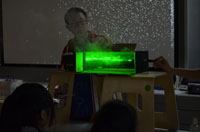
Science Demonstration
Service in the Museum: Free of charge, not supplied at the school
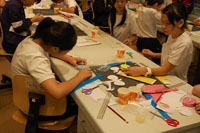
Workshops
Service in the Museum: Free of charge
Service at the School: MOP 30.00
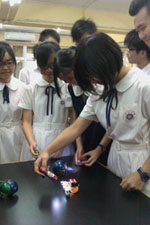
Electronic Circuit Courses
Service in the Museum: Free of charge
Service at the School: MOP 70.00 per student, S3-E05 and S3-E08 not supplied at the school
03-003 Science College (Secondary, Primary)
Service at the School: Free of charge, not supplied in the museum
- Revolution of Optical Fibre
- The Invention of LED
- Story of the Light
Public Activities
Interactive Exhibit: Optical Phone
The concept of "Optical Phone" originates from the photophone proposed by Alexander Bell. After his invention of telephone in 1876, Alexander Bell continued and soon successfully experimented on the photophone, which he regarded it as his greatest inventions. When the visitor takes up the torch of the exhibit, points the light beam at the receiver on the opposite side and talks to the phone, the light beam will change according to the voice. Light signal will be transformed into electric signal through the receiver so that the recipient can hear the voice of the sender on the phone. Therefore, visitors can operate the "Optical Phone" as a "wireless phone", and share the excitement of photophone invention by Alexander Bell more that a hundred years ago.
Workshops of LED's Changing Looks
A. LED Festival
Light-Emitting Diode (LED) is a two-lead semi-conductor light source. Nowadays it is widely used in monitors, lighting, etc. The research on LED started in 1907 when the British scientist, Henry Joseph Round, discovered that silicone carbide will illuminate with a current flow of electricity. However, only until 1962 did LED start to be commercialized when infrared LED was developed. The 2014 Nobel Prize in Physics was awarded to two Japanese scientists and one American scientist for their inventions of high-brightness blue LED which has brought a bright and energy-saving white light source to the world. Participants will learn the basic theories of LED and make a festive lamp stand in the workshop.
Registration: Please submit your online registration one month before the class starts. Payment should be made on the day of class. First come first served.
| Theme |
Time |
Level |
Audience |
Participants |
Charge of Material |
|
| A1. Easter Treasures |
Mar.28 (Sat) 14:30 - 17:30 |
Basic |
Family & friends (2 persons) |
10 groups |
MOP50 per group |
|
| A2. Summer Fragrance |
Jul.25 (Sat) 14:30 - 17:30 |
Basic |
P.5 of above |
20 persons |
MOP50 |
|
| A3. Summer Fragrance |
Aug.1 (Sat) 14:30 - 17:30 |
Basic |
P.5 of above |
20 persons |
MOP50 |
|
| A4. Mid-Autumn Lanterns |
Sept.26 (Sat) 14:30 - 17:30 |
Advanced |
F.1 or above |
20 persons |
MOP50 |
|
| A5. Halloween Pumpkin |
Oct.31 (Sat) 14:30 - 17:30 |
Advanced |
F.1 or above |
20 persons |
MOP50 |
|
| A6. Christmas Caroling |
Nov.28 (Sat) 14:30 - 17:30 |
Advanced |
F.1 or above |
20 persons |
MOP50 |
|
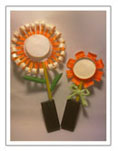
Summer Fragrance
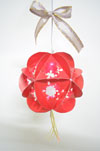
Mid-Autumn Lanterns

Halloween Pumpkin
B. Pinhole Camera
Communications Museum and Maritime Museum jointly organize this special activity to celebrate the International Year of Light and 150th anniversary of the Macau Guia Lighthouse. Participants will learn the principles of optics related to camera and make a pinhole camera in the workshop. They will also be arranged to visit and take photos at the Guia Lighthouse. The photos taken will be exhibited at the Maritime Museum and Communications Museum.
Registration: Please submit your registration and payment at the Reception Counter of Communications Museum before 13 June (Saturday). First come first served.
| Group |
Date |
Content |
Target |
Participants |
Price of Material |
| B1 |
Jun.13 (Sat.) |
10:00 - 13:00
CMM: Theory & production |
F.4 or above |
15 persons |
MOP120 |
| Jun.27 (Sat.) |
08:30 Visit the Guia Lighthouse & photo-taking
14:30 CMM: Film prints |
| B2 |
Jun.13 (Sat.) |
14:30 - 17:30
CMM: Theory & production |
15 persons |
MOP120 |
| Jun.27 (Sat.) |
08:30 visit the Guia Lighthouse & photo-taking
14:30 CMM: Film prints |
SciTech Talk - Optogenetics
Optogenetics is a combination of techniques from optics and genetics to precisely control the activities of individual cells in time and space. Time can be precisely measured in millisecond and space can be measured by the size of individual cells. In 2005, when the scientists first applied channelrhodopsin to neurons, they discovered that blue light can accurately control the activation of neurons. Since then the term Optogenetics arises.
The seminar is jointly organized with the Macau Society of Biomedical Engineering to introduce the development and application of cutting-edge echnology to secondary students and teachers. It is hoped to encourage more young people to be more aware of and join the study and research of biomedical engineering.
Item: S3-D02 "Optical Fibers"
Audience: Form 1 or above
Duration: 40 minutes
Content:
Optical fiber is an important medium in modern communication. From the Internet to medical equipment, optical fiber is influencing our lives. Recently, telecom operators began providing Fiber to the Home Broadband Service. The access speed is much faster than before and users comment that the speed is incomparable. Optical fiber has suddenly become a hot topic. But what is optical fiber? What are the theories behind it? What benefits has it brought us?
The demonstration will mainly introduce the structure of optical fibers, the theories of message transmission, and compare optical fiber and copper wire, including:
- History of wired communication: Usage of copper wire and its limitations, optical communication at its early stage.
- Operational theories of optical fibers - Characteristics of light: Introduce reflection, refraction and the linear propagation of travel as characteristics of light.
- Operational theories of optical fibers - Optical phenomena of total internal reflection: Use simple tools to demonstrate a light guiding experiment of a water column.
- Operational theories of optical fibers - The birth of modern optical fibers: Introduce the technical difficulties encountered in producing modern optical fibers, the production methods and various types of optical fibers.
- Operational theories of optical fibers - Experiment of sound transmission through optical fibers: The use optical fibers to transmit optical signals.
- Difference between optical fiber and copper wire - Physical properties: Compare the physical properties of optical fibers and copper wire.
- Difference between optical fiber and copper wire - Anti-electromagnetic influence experiment: Use optical fibers and copper wire as the medium of transmission, observe their interference conditions.
- Applications of optical fibers: Endoscope, optical fiber network (data transmission), compare broadband internet access through optical fibers and fixed line (ADSL).
Item: S3-D03 "Laser"
Audience: Form 4 or above
Duration: 40 minutes
Content:
In 1960, a kind of magical light "laser" was born. Since then, laser quite often appears in science fiction movies. Does laser exist only in the future high technological world? Or does it actually exist in our daily life? Let's explore and discover more about this fascinating magical light!
The demonstration concerns the theories and properties of laser, and also its applications, including:
- The theories of the production of laser: Explain the atomic structure of substance, the principle of energy levels and electronic transition, and the production methods of laser.
- Properties of laser - Path: Demonstrate the transmission path of laser.
- Properties of laser - Direction: Comparison between regular light source and laser.
- Properties of laser - Coherence: Explain the coherence of laser.
- Properties of laser - Monochrome: Introduce the monochromatic light transmission of laser.
- Applications of laser - Cutting: Demonstrate cutting of paper, glass, plastic and different materials using a CO2 laser cutter.
- Applications of laser - Communication: Demonstrate and explain the application of optical fibers in communication, and the switching methods between analog and digital signals.
- Applications of laser - Others:Introduce the applications of laser in other areas.
- The safety of laser: Explain the danger of laser and demonstrate with strong laser beams.
Item: S3-D05 "Light and Colours"
Audience: Primary 4 or above
Duration: 40 minutes
Content:
Sunlight not only gives us light and warmth, but also a lot of beautiful natural phenomena like rainbow, blue sky and sunset glow, etc. But have we ever though about these phenomena are related to the magical effects of light? Light enables us to see our colourful world. Colour is actually a visual effect in response to light produced as seen through our eyes, brain and past experiences.
The demonstration is about the properties of light and related phenomena, including:
- Properties of light: Make use of laser to demonstrate the linear propagation of light, reflection and refraction.
- Dispersion phenomena of light - Compare sunlight, white light and laser by observing their refraction properties after passing through a prism.
- Dispersion phenomena of light - Make an artificial rainbow. Observe and analyze the factors that led to the creation of a rainbow.
- Dispersion phenomena of light - Properties of rainbow: Why is it a curve? Why is it always in a high up position? From which angle can we see a rainbow?
- Types of colours: Compare monochromatic light and coloured light; mixing of the colours of light and the origin of the three primary colours. Use different colour lights to compose lights of different colours.
- Relationship between colour of objects and light: Explain how the colours of objects are brought about. Compare the different colours of objects under lamps of different colours.
- Applications: 3D glasses, stage effect and filter.
Item: S3-W02 "Optical Fibers DIY"
Audience: Primary 4 to Form 3
Duration: 60 minutes
Content:
Can you imagine how optical fibers will influence our present and future life? Let us make a simple optical fiber souvenir in order to understand the characteristics, basic transmission theory and its applications in our daily lives.
Charge:
Held in the museum - Free of charge. At schools - MOP30.00 per student.
Item: S3-W16 "Simple Periscope"
Audience: Primary 1 to 4
Duration: 60 minutes
Content:
Based on the principle of light reflection, the periscopes used in submarines are made for observing the water surface from the submarine. Let's make a periscope with simple materials to understand its structure and principle.
Charge:
Held in the museum - Free of charge. At schools - MOP30.00 per student.
Item: S3-W17 "Simple Telescope"
Audience: Primary 3 to 6
Duration: 60 minutes
Content:
How does a telescope bring distant objects to the front of our eyes? Let's make a simple telescope (the simplest one can be made only by 2 mirrors!) and understand how the principles of reflection and refraction are applied in telescopes.
Charge:
Held in the museum - Free of charge. At schools - MOP30.00 per student.
Item: S3-W18 "Bling Bling Kaleidoscope"
Audience: Primary 5 to 6
Duration: 60 minutes
Content:
Why does the pattern inside a kaleidoscope change when we slightly rotate it? Kaleidoscope is actually an optical toy that consists of three mirrors inside the tube. With light reflection, the colored bits of glasses inside the tube will form different beautiful and colorful patterns.
Charge:
Held in the museum - Free of charge. At schools - MOP30.00 per student.
Item: S3-W19 "Pinhole Camera"
Audience: Primary 6 to Form 2
Duration: 60 minutes
Content:
Do you know how a camera works? Actually the principles of most cameras work are similar. Let's make a simple pinhole camera to see how an image is projected by light rays and, hence, the principles of a camera.
Charge:
Held in the museum - Free of charge. At schools - MOP30.00 per student.
Item: S3-E02 "Application of Photodiode - Photosensitive Mechanical Beetle"
Audience: Form 3 or above, completion of S3-E01 is recommended
Duration: 4 weeks, 10 hours
Content:
Students will be introduced about LEDs, photodiodes, NPN type transistors, DC motor and their application as a whole. They will use the above-mentioned components to build a photosensitive mechanical beetle, which follows light to guide its way.
LED is a semiconductor component widespread and popular due to its long service life, versatile color changing ability and low power consumption. Applications of LEDs are so diversified in fabrication of indicator light, display boards and lighting that they show many advantages over traditional light sources, such as lower energy consumption, longer lifetime, improved robustness, smaller size and faster switching.
A photodiode is a typical photo detector which is capable of converting light into either current or voltage, depending upon the mode of operation. It is usually found in automatic control system.
Transistor is a semiconductor device commonly used to amplify or switch electronic signals. The NPN transistor used in this course is like a switch where the input voltage is applied to change the output current. Unlike other mechanical switches, transistor can use electrical signals to control the switch "on" and "off" with high speed.
Charge:
Held in the museum - MOP50.00 per student. At school - MOP70.00 per student.
Outline:
Lesson 1 - Review of electronic components and soldering technique.
Lesson 2 - Introduction to LED, photodiode, NPN transistor and DC motor.
Lesson 3 - Constructing a photosensitive mechanical beetle.
Lesson 4 - Constructing a photosensitive mechanical beetle.
Item: S3-E05 "Application of Infrared Communication Technology"
Audience: Form 4 or above
Duration: 4 weeks, 10 hours
Content:
Infrared (IR) is an electromagnetic wave whose wavelength is longer than visible light but shorter than microwave. Since no physical connection and no complicated components are needed for IR communications, the cost of transmission is lower. This explains why it has become a common technology applied in portable computer, mobile phones and other transmission equipment for data transfer. It is also used in the remote control of TV, air-conditioner and other household appliances.
This course allows students to experience the applications of infrared in our daily life by making gadgets by themselves. Participants will produce an infrared receiver that connects to the computer and use an ordinary household remote control to substitute the operation of the mouse or keyboard of the computer.
Charge:
Held in the museum - MOP50.00 per student. This course cannot be done at schools because oscilloscopes are needed.
Outline:
Lesson 1 - Introduction to 555 monostable oscillating circuit.
Lesson 2 - Introduction to infrared communication technology and making the receiver.
Lesson 3 - Making the circuit of receiver.
Lesson 4 - Introducing the WinLIRC and making a PC remote control.
Item: S3-E08 "Application of Operational Amplifiers - Hearbeat Sensor"
Audience: Form 4 or above, completion of S3-E01 is recommended.
Duration: 4 weeks, 10 hours
Content:
The infrared rays from an Infrared LED can pass through human skin. When the heart beats, blood flows through the blood vessels inside our fingers. At the same time, the infrared rays received by the photodiode also changes, which results in a weak electric signal. When this electric signal is magnified by an operational amplifier, which in turn lights up an LED, we can observe the heart rate. In this course, participants will learn how to make a simple Heart Rate Monitor and learn about the application of operational amplifier in our daily life.
Charge:
Held in the museum - MOP70.00 per student. This course cannot be done at schools because oscilloscopes are needed.
Outline:
Lesson 1 - Basic principles of electric circuits and heart rate monitors.
Lesson 2 - Basic principles of operational amplifiers.
Lesson 3 - Production of heart rate monitor.
Lesson 4 - Production of heart rate monitor.






